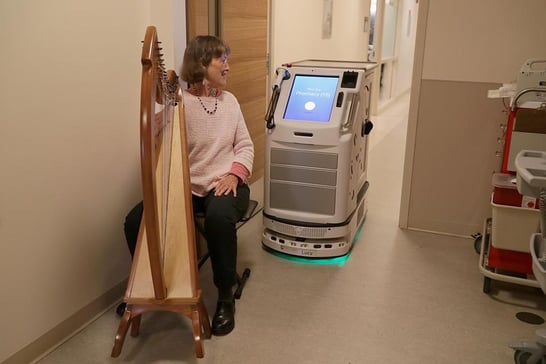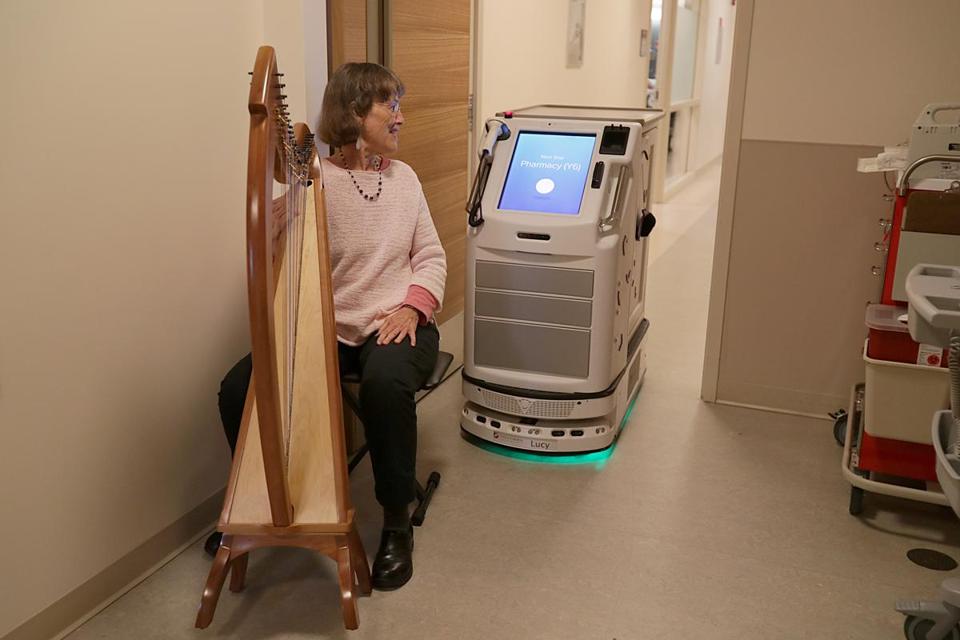 Technology continues to make strides in both our professional and personal lives. This article is about a robot that’s being tested to deliver medication to chemo patients, thus eliminating the step of having to wait in line for medication after a very lengthy day of chemo. This is a new technology being tested at Dana Farber Cancer Institute and patients are enthusiastic about it.
Technology continues to make strides in both our professional and personal lives. This article is about a robot that’s being tested to deliver medication to chemo patients, thus eliminating the step of having to wait in line for medication after a very lengthy day of chemo. This is a new technology being tested at Dana Farber Cancer Institute and patients are enthusiastic about it.It’s an unusual sight in the halls of Dana-Farber Cancer Institute: Alongside doctors, nurses, and patients, a robot about the size of a washing machine quietly glides through the hospital, a bright light marking its presence.
Dana-Farber executives have high hopes for “Lucy,” one of the newest technologies in use at Boston’s best-known cancer center. Lucy is being developed to deliver prescription drugs directly to patients while they sit in infusion rooms receiving chemotherapy — a treatment that can take many hours. If the system works, it will save patients the time and trouble of having to stand in line to pick up their prescriptions at a pharmacy after an already long and draining day of treatment.
“We want Lucy to be able to improve the patient’s experience while they’re here all day,” said Sylvia Bartel, vice president of pharmacy at Dana-Farber. “Their last stop is usually coming to the outpatient pharmacy and picking up a prescription. They finish their chemotherapy, they have to wait in a line, so we felt like there had to be a way for us to efficiently deliver the [medications] using technology.”
Dana-Farber began testing the technology in 2013, after getting a phone call from executives at Vecna Technologies, the Cambridge-based company that developed the robot and was looking to expand its health care business. The Boston cancer center is one of just a few hospitals in the world using the machine.
Lucy is equipped with a touchscreen, a scanner, and compartments for stocking drugs. There is no attempt to give it human features, other than a voice only used occasionally. For now, the robot doesn’t interact with patients, only with hospital staff. It moves drugs around the Longwood area hospital, making about a dozen trips a day, using Wi-Fi-connected software to open doors and use service elevators.
Lucy isn’t glitch-free. It has ended up on the wrong floor before. On one recent afternoon, its movements were halting. Another day, it was out of service because of a connectivity problem.
Even so, Carlos Verrier, business operations manager in Dana-Farber’s pharmacy, said Lucy has helped make the pharmacy more productive. The hospital pharmacy is a busy place, processing some 400 scrips a day.
“It’s really allowing the staff to do more of what they’re trained to do... and not having to take them away to do a delivery,” Verrier said. “They spend more time on clinical aspects of their job than on delivering medication.”
Deborah Theobald, Vecna’s chief executive, said there’s a lot of potential for using such robots to move sensitive items around a hospital. Robots can move potent, expensive drugs around a building more safely and securely than humans, she said. Their every move can be easily tracked.
Vecna’s QC Bot costs roughly $150,000. Theobald acknowledged that hospital executives may need some persuading before they’re ready to give it a try.
“There’s an education process to get them over the hump and see the [return on investment],” she said. “People really appreciate robots once you get over the education hurdle. People don’t want to go back.”
Anne Tonachel, a former patient and current volunteer at Dana-Farber, has seen Lucy moving around the halls and quickly become a fan.
Tonachel is an ovarian cancer survivor who vividly remembers the pain of receiving chemotherapy treatment for many hours at a time. The treatments left her feeling too sick to pick up prescriptions from the pharmacy. Tonachel said she would have loved to skip that step by having a robot deliver prescriptions directly to her.
“No one would mind having Lucy show up at their bed or chair side,” she said. “In fact, her arrival might add a bit of interest to the day and bring a few smiles.”







